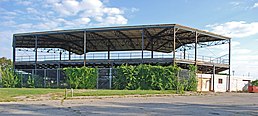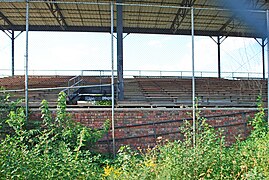
Shibe Park, known later as Connie Mack Stadium, was a ballpark located in Philadelphia. It was the home of the Philadelphia Athletics of the American League (AL) and the Philadelphia Phillies of the National League (NL). When it opened April 12, 1909, it became baseball's first steel-and-concrete stadium. In different eras it was home to "The $100,000 Infield", "The Whiz Kids", and "The 1964 Phold". The venue's two home teams won both the first and last games at the stadium: the Athletics beat the Boston Red Sox 8–1 on opening day 1909, while the Phillies beat the Montreal Expos 2–1 on October 1, 1970, in the park's final contest.

Norman Thomas "Turkey" Stearnes was an American baseball center fielder. He played 18 years in the Negro leagues, including nine years with the Detroit Stars (1923–1931), six years with the Chicago American Giants, and three years with the Kansas City Monarchs (1938–1940).
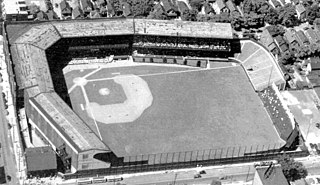
League Park was a baseball park located in Cleveland, Ohio, United States. It was situated at the northeast corner of Dunham Street and Lexington Avenue in the Hough neighborhood. It was built in 1891 as a wood structure and rebuilt using concrete and steel in 1910. The park was home to a number of professional sports teams, most notably the Cleveland Indians of Major League Baseball. League Park was first home to the Cleveland Spiders of the National League from 1891 to 1899 and of the Cleveland Lake Shores of the Western League, the minor league predecessor to the Indians, in 1900. From 1914 to 1915, League Park also hosted the Cleveland Spiders of the minor league American Association. In the 1940s, the park was also the home field of the Cleveland Buckeyes of the Negro American League.

Griffith Stadium stood in Washington, D.C., from 1911 to 1965, between Georgia Avenue and 5th Street, and between W Street and Florida Avenue NW.

Kansas City Municipal Stadium was an American baseball and football stadium in the central United States, located in Kansas City, Missouri. It was located at the corner of Brooklyn Avenue and E. 22nd Street.
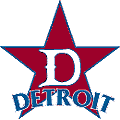
The Detroit Stars were an American baseball team in the Negro leagues and played at historic Mack Park. The Stars had winning seasons every year but two, but were never able to secure any championships. Among their best players was Baseball Hall of Famer Turkey Stearnes.
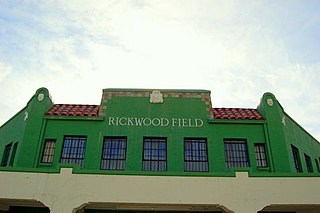
Rickwood Field, located in Birmingham, Alabama, is the oldest existing professional baseball park in the United States. It was built for the Birmingham Barons in 1910 by industrialist and team-owner Rick Woodward and has served as the home park for the Birmingham Barons and the Birmingham Black Barons of the Negro leagues.

Royal Athletic Park is a stadium in Victoria, British Columbia, and is used for baseball, soccer, softball and football, but also hosts special events, such as the annual Great Canadian Beer Festival and previously the Rifflandia Music Festival. It is home to the Victoria HarbourCats Baseball Club of the West Coast League. It is located 1 km from the city centre.
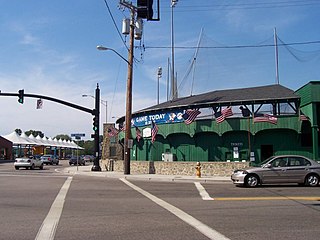
Cardines Field is a baseball stadium located at 20 America’s Cup Avenue in Newport, Rhode Island. It is believed to be one of the oldest ballparks in the United States and has been called "a small urban gem of a ballpark". The field serves as a buffer between the residential and commercial sections of an older part of Newport. The oddly shaped outfield fence and dimensions are created by the close proximity of residential housing, while the spectator side of the park is contained by America's Cup Avenue and West Marlborough Street. Originally called Basin Field, references to the field can be found as early as 1893. At that time, the property was used by local railroads as a drainage and supply basin for steam engines. Complaints from neighbors about the stagnant water and mosquitoes prompted the drainage of the basin area, permitting baseball to be played. A local historical debate continues as to whether baseball was played prior to 1900, making Cardines one of the oldest existing ballparks in the country, or if play didn't begin until 1908, the earliest documented proof of stadium construction.
Mack Park was the original home field of Detroit's Negro National League baseball franchise, the Detroit Stars. It was constructed in 1914 by Joe Roesink, sponsor of a local semi-professional team, a Dutchman of Jewish descent born in Grand Rapids who owned a chain of haberdasheries.
Gary Gillette is a baseball writer, author, and editor. He is co-editor of both the ESPN Baseball Encyclopedia and the ESPN Football Encyclopedia. For both series of books, he partnered with noted statistician Pete Palmer, as well as writers Sean Lahman and Matt Silverman.
The 1928 Detroit Stars baseball team competed in the Negro National League during the 1928 baseball season. The team lost to the St. Louis Stars in the race for the Negro National League pennant. In games for which newspaper accounts have been found, the team compiled a 52–26 (.667) record.
The 1925 Detroit Stars baseball team competed in the Negro National League during the 1925 baseball season. The team compiled a 56–44 record (.560) in games against National League opponents. The Stars played their home games at Mack Park located on the east side of Detroit, about four miles from downtown, at the southeast corner of Fairview Ave. and Mack Ave. The team was owned by John A. Roesink and managed on the field by catcher-manager Bruce Petway.
The 1930 Detroit Stars baseball team competed in the Negro National League during the 1930 baseball season. The team compiled a 54–41 record, had a 24-game winning streak in July and August, won the league's second-half championship, and lost to the St. Louis Stars in a postseason series billed as the "Negro World Series".
The 1924 Detroit Stars baseball team competed in the Negro National League (NNL) during the 1923 baseball season. The Stars compiled a 35–31–1 record (.530) and finished third in the NNL.
The 1926 Detroit Stars baseball team competed in the Negro National League (NNL) during the 1926 baseball season. The team compiled a 52–47–1 record (.525) and finished fourth in the NNL. The Stars played their home games at Mack Park located on the east side of Detroit, about four miles from downtown, at the southeast corner of Fairview Ave. and Mack Ave. The team was owned by John A. Roesink and managed by Bill Riggins and Candy Jim Taylor.
The 1927 Detroit Stars baseball team competed in the Negro National League (NNL) during the 1927 baseball season. The team compiled a 52–47 record (.525) and finished fifth in the NNL. The Stars played their home games at Mack Park located on the east side of Detroit, about four miles from downtown, at the southeast corner of Fairview Ave. and Mack Ave. The team was owned by John A. Roesink and managed by Bingo DeMoss.
The 1929 Detroit Stars baseball team competed in the Negro National League (NNL) during the 1929 baseball season. The team compiled a 44–45 record (.494) and finished fifth in the NNL. The Stars played their home games at Mack Park located on the east side of Detroit, about four miles from downtown, at the southeast corner of Fairview Ave. and Mack Ave. The team was owned by John A. Roesink and managed by Bingo DeMoss.
The 1931 Detroit Stars baseball team competed in the Negro National League (NNL) during the 1931 baseball season. The team compiled a 25–33 record (.431) and finished fourth in the NNL. The Stars played their home games at Mack Park located on the east side of Detroit, about four miles from downtown, at the southeast corner of Fairview Ave. and Mack Ave. The team was owned by John A. Roesink and managed by Bingo DeMoss.
